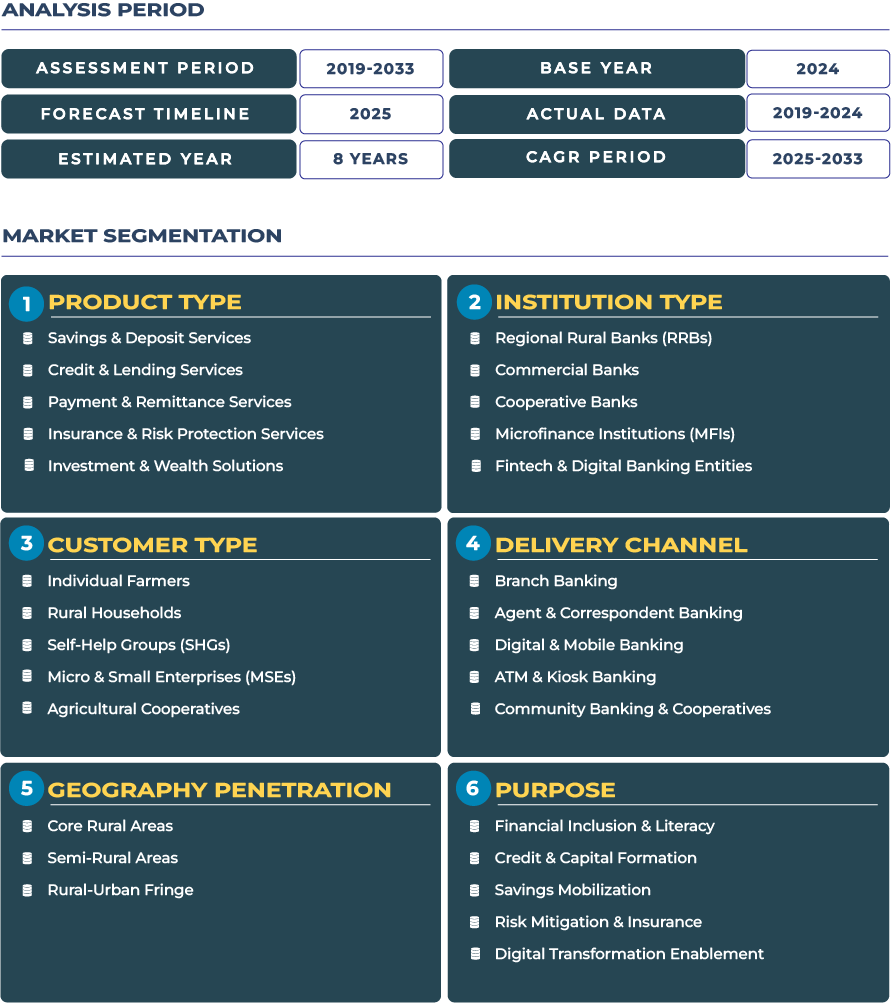Qatar Rural Banking Market Outlook: Financing Controlled-Environment Agriculture for Food Sovereignty
Qatar rural banking market is reshaping its agricultural paradigm through high-tech, controlled-environment (CE) systems that address the country’s resource and land limitations. The rural banking ecosystem plays a critical role in financing advanced agritech projects such as hydroponics, vertical farming, and energy-efficient greenhouses. This strategic financial alignment supports the national food security framework led by Qatar’s Ministry of Commerce and Industry and the sustainable investment initiatives driven by the Qatar Central Bank. The combination of state-led policy and targeted credit delivery is fostering resilient, technology-backed rural development in an arid geography.
Note:* The market size refers to the total fees/revenue generated by banks through various services.
According to DataCube Research, the Qatar Rural Banking Market is projected to grow from USD 1.0 billion in 2025 to USD 1.1 billion by 2033, registering a CAGR of 1.0%. Despite moderate growth, the sector remains essential in diversifying Qatar’s non-hydrocarbon economy. Financing for CE agriculture, desalination-linked irrigation, and cross-border agri-leasing are the defining elements ensuring Qatar’s self-reliance in food and agri-input production.
Building Food Sovereignty Through Controlled-Environment Finance
Qatar rural banking sector is positioned as a catalyst in achieving the nation’s food security goals by funding CE agriculture ventures. This includes investments in fully automated greenhouses, aquaponics, and hybrid solar-desalination systems that minimize water consumption while maximizing yield. The Gulf Cooperation Council (GCC) regional collaboration framework has also encouraged knowledge and capital exchange in the agritech domain, promoting a sustainable financing culture within rural development schemes.
Rural banking institutions are shifting toward concessional lending structures that align with the government’s long-term sustainability vision. The integration of digital payment platforms and low-interest agri-asset financing mechanisms enhances accessibility for small-scale rural operators. Moreover, Qatar’s stable political climate and fiscal surpluses provide a robust backdrop for agritech financing, mitigating the risks associated with import dependency and supply chain volatility triggered by global geopolitical tensions.
Drivers and Restraints: Balancing National Ambition with Resource Realities
National Food-Security Investments Drive Market Stability and Innovation
The primary growth driver of the Qatar rural banking landscape is the state’s commitment to food independence through sovereign fund-backed financing. Initiatives under the Qatar Investment Authority support CE agriculture expansion and offshore farmland leasing across Africa and South Asia, ensuring long-term food import substitution. Moreover, fund-backed ag-tech pilots involving greenhouse automation and desalination-powered hydroponics have attracted institutional participation from domestic and regional lenders.
Rural credit schemes are increasingly linked to sustainability-linked metrics, enabling borrowers to access reduced interest rates for achieving productivity and water-efficiency benchmarks. This performance-based lending model creates accountability and aligns with Qatar’s National Vision 2030 priorities of diversification and sustainability.
Structural Constraints: Small Domestic Market and Energy-Linked Costs
Despite these advancements, Qatar rural banking sector faces limitations stemming from its small agricultural base and high dependence on imported inputs. Limited arable land and high desalination energy costs inflate capital requirements for CE agriculture ventures. Furthermore, rural credit portfolios remain narrow compared to urban finance, as banks must rely on sovereign guarantees or project bundling to offset exposure risks. This structural reality caps the expansion rate of rural banking penetration, even as technology adoption accelerates in pilot clusters around Al Khor and Al Rayyan.
Trends and Opportunities: Financing the Future of Sustainable Agritech
Sovereign-Backed Greenhouse Pilots and Offshore Leasing Finance Redefine Rural Credit
The ongoing trend of sovereign-backed greenhouse pilots is revolutionizing Qatar’s agritech finance landscape. Structured financing through public-private partnerships is creating viable models for year-round food production under extreme climatic conditions. Banks are using hybrid credit products that integrate lending, insurance, and performance guarantees, ensuring financial resilience in the rural value chain.
Simultaneously, offshore farmland leasing projects financed by Qatari institutions offer a scalable opportunity for diversifying food production geography. By underwriting these projects with offtake guarantees, rural banks create circular credit flows that ensure repayment certainty while supporting national food strategy.
Opportunity Landscape: Finance for CE Agriculture and Cross-Border Agritech Projects
Opportunities lie in expanding financial products tailored for CE agriculture startups, desalination-linked farms, and controlled irrigation networks. Qatar’s commercial banks and specialized rural finance institutions are piloting agri-insurance schemes and investment-linked savings accounts designed for cooperative producers and agri-exporters. The deployment of digital banking tools enhances rural credit accessibility, particularly in underbanked zones and new agritech clusters. Additionally, cross-border project finance mechanisms for leasing agricultural land in strategic food-producing nations are expected to gain traction through 2033.
Competitive Landscape: Institutional Financing Powers High-Tech Agriculture
Rural Banks Deepen Engagement Through Structured Debt and Offshore Finance
The competitive landscape of the Qatar rural banking industry is evolving with strategic collaborations between sovereign funds, commercial banks, and agritech developers. Institutional lenders are focusing on reducing early-stage risk through staged financing models while leveraging sovereign backing to support private sector participation. The Qatar National Bank (QNB) and other financial institutions continue to pioneer integrated investment products combining rural lending with export facilitation, aligning financial objectives with national policy imperatives.







